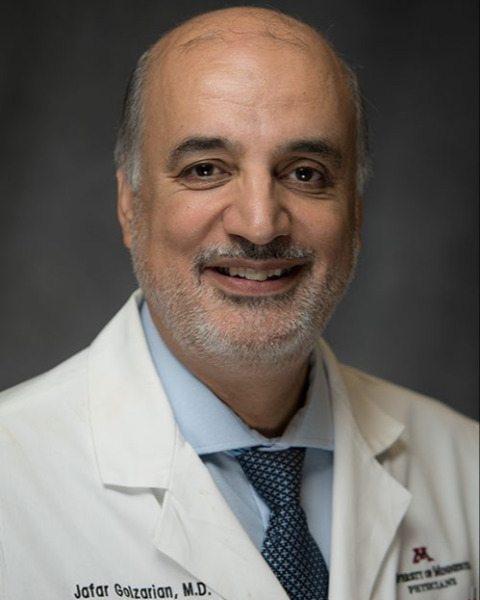Abstracts
Treatment of knee osteoarthritis with genicular artery injection of mesenchymal stem cells: preliminary results
Saturday, May 20, 2023
10:39 AM - 10:48 AM East Coast USA Time
Location: Empire East Ballroom

Jafar Golzarian, MD
Professor of Radiology and Surgery
Division Head, Vascular and Interventional Radiology
University of Minnesota
University of Minnesota
Plymouth, Minnesota, United States
Speaker(s)
Background: n/a
Purpose/Objective: The aim of this study was to evaluate the role of intra-arterial mesenchymal cell injection in the management of knee osteoarthritis.
Materials & Methods: After IRB and the ethics committee's approval, 30 patients with moderate knee osteoarthritis (OA) were treated. All patients had an MRI prior the procedure confirming the OA. After accessing the contralateral femoral artery, the genicular artery leading to the vascular blush was catheterized. The solution of mesenchymal stem cells(70 million allogenic cells) was then injected in the vessel. All the patients were admitted for one day following the procedure. MRI of the knee is planned in all patients at one month. WOMAC scores were obtained before and weekly after the intervention.
Results: Technical success rate was 100%. 30 patients have completed clinical, and imaging follow up at one month. They were divided to four age groups and their womac score resaults recorded in 4 weeks as described below:
A) Womac Score for age>55 (n=16): “32.63” reduced to “7.69”
B) Womac Score for age<=55 (n=14): “25.14” reduced to “3.36”
C) Womac Score for weight>70 (n=17): “27.76 reduced to 5.47”
D) Womac Score for weight<=70 (n=13): ”30.92 reduced to 5.92”
The average WOMAC score before the intervention, was about (25.14 - 32.63), and it dropped to about (7.69 – 3.36) on one month. This reduction on mean WOMAC numbers is statistically significant. Patient symptoms improved significantly. MRIs of the knee have demonstrated a significant regeneration of the affected cartilage and the subchondral lesions.
Measurement analysis of the joint areas are recorded in the table attached:
Conclusion: This preliminary study is promising demonstrating that intra-Genicular artery injection of mesenchymal Stem Cells not only improves clinical symptoms, but also results in early cartilage regeneration. In addition to pain improvement and cartilage regeneration, MRI Pictures demonstrate that in some patients subchondral changes improved significantly.
Purpose/Objective: The aim of this study was to evaluate the role of intra-arterial mesenchymal cell injection in the management of knee osteoarthritis.
Materials & Methods: After IRB and the ethics committee's approval, 30 patients with moderate knee osteoarthritis (OA) were treated. All patients had an MRI prior the procedure confirming the OA. After accessing the contralateral femoral artery, the genicular artery leading to the vascular blush was catheterized. The solution of mesenchymal stem cells(70 million allogenic cells) was then injected in the vessel. All the patients were admitted for one day following the procedure. MRI of the knee is planned in all patients at one month. WOMAC scores were obtained before and weekly after the intervention.
Results: Technical success rate was 100%. 30 patients have completed clinical, and imaging follow up at one month. They were divided to four age groups and their womac score resaults recorded in 4 weeks as described below:
A) Womac Score for age>55 (n=16): “32.63” reduced to “7.69”
B) Womac Score for age<=55 (n=14): “25.14” reduced to “3.36”
C) Womac Score for weight>70 (n=17): “27.76 reduced to 5.47”
D) Womac Score for weight<=70 (n=13): ”30.92 reduced to 5.92”
The average WOMAC score before the intervention, was about (25.14 - 32.63), and it dropped to about (7.69 – 3.36) on one month. This reduction on mean WOMAC numbers is statistically significant. Patient symptoms improved significantly. MRIs of the knee have demonstrated a significant regeneration of the affected cartilage and the subchondral lesions.
Measurement analysis of the joint areas are recorded in the table attached:
Conclusion: This preliminary study is promising demonstrating that intra-Genicular artery injection of mesenchymal Stem Cells not only improves clinical symptoms, but also results in early cartilage regeneration. In addition to pain improvement and cartilage regeneration, MRI Pictures demonstrate that in some patients subchondral changes improved significantly.
